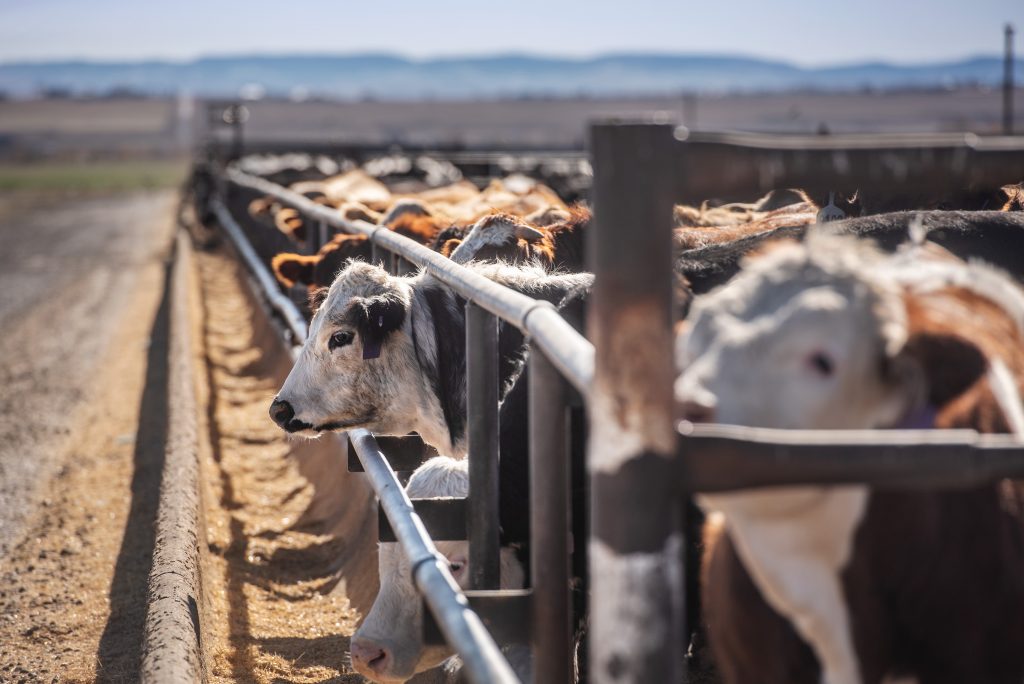AB Direct - Steers
Rail: 493.00-495.00 del
AB Direct - Heifers
Rail: 493.00-495.00 del
US Trade- Steers
Rail: 355.00 (IA, NE)
US Trade - Heifers
Rail: 355.00 (IA, NE)
Canadian Dollar
0.06

Using antimicrobials sustainably
Antimicrobial use in beef cattle production greatly benefits animal health. But, it has come under scrutiny in recent years, due to increasing incidents of antimicrobial resistance. To bring you the full story, we spoke to an animal health scientist and a feedlot veterinarian about the benefits and challenges of antimicrobial use, the developing risk of resistance, and best practices to ensure these important tools benefit animal health for generations to come.
Antimicrobials (AMs) support human and animal health by inhibiting or destroying the growth of microorganisms. Their use in beef cattle production (particularly the use of antibiotics) supports animal health by preventing, treating and reducing the incidence of disease (particularly bovine respiratory disease, or BRD).
BRD causes mild to severe illness, spreads between animals, and has compounding negative effects on animal welfare in the feedlot environment. While AMs have benefited cattle health for many years, their use has occurred in conjunction with a concerning increase in the presence of antimicrobial resistance (AMR), an area of study for Canadian researchers since the early 1990s.
“When we first started studying this we found very low levels of resistance in many of the bacteria responsible for BRD,” explains Dr. Tim McAllister, Research Scientist, Ruminant Nutrition and Microbiology, Agriculture and Agri-food Canada. “Over the years we’ve seen an increase. We now find that bacteria resistant to tetracycline is pretty widespread, and in the last five to ten years we’ve also seen a huge increase in resistance to the macrolide family of antibiotics, which is the family many producers use to control the bacteria that cause BRD.”
Increasing AMR in animals might be a concern for human health if resistant bacteria cross species through the environment or by beef consumption. But there is good news on that front. Significant research has been done, and findings indicate this transfer occurs only in very rare, isolated cases. “Our research suggests there is limited movement of resistance from beef cattle to humans,” McAllister says.
Unfortunately, however, increasing resistance is resulting in reduced effectiveness of many AMs for controlling infectious disease in cattle, and that poses a significant problem. “Within the feedlots, we are definitely seeing that many AMs are not as effective as they were when they first came out, which aligns with the idea that there is growing antimicrobial resistance within those bacterial populations,” McAllister says.

Use is now more tightly controlled
As a result of growing concern about AMR, government regulations have changed. “Changes to legislation have resulted in the need for more oversight and regulatory compliance to use AMs in animal production,” explains Dr. Calvin Booker, Veterinarian and General Manager of Services and Research with Feedlot Health Management Services by TELUS Agriculture.
Producers who used to be able to purchase AMs over-the-counter through feed mills or agriculture supply stores can now only access them as prescribed by a veterinarian. This increases the importance of working with a veterinarian to manage animal health. “For most feedlots this hasn’t changed how they use AMs, because most were already working with veterinarians for helping to prevent, control and treat disease,” Booker says.
The increased oversight is more restrictive, frustrating some producers. But Booker suggests perhaps antimicrobial use (AMU) should have been under tighter control from the start. “From a veterinary perspective, this seems like a reasonable principle of AM stewardship. AMs are valuable tools to manage disease in animal and human populations, and we should have a fair degree of oversight in how they are used,” he says.
At present, most feedlot operators keep very accurate records about AMU. They know how much has been administered to which animals, and can use the data collected to assess effectiveness of treatments based on disease incidence following treatment.
Additionally, the National AMU and AMR feedlot surveillance program initiated in 2019 collects samples to look for AMR. Surveillance of both AMU and AMR will help researchers investigate associations between the two, and identify what factors are contributing to AMR development, spread and persistence.
“AMU surveillance involves documenting and measuring how AMs are prescribed and administered, and monitoring trends over time…AMR surveillance is the effort to provide representative estimates of AMR and monitor trends over time,” explains Dr. Sheryl Gow, Veterinary Epidemiologist with the Public Health Agency of Canada.
While it’s not possible to evaluate why and how much AMU is taking place, opportunities for modifications to reduce AMU may be identified through surveillance, says Gow. Further, “Research and surveillance together will provide a better understanding of the development, spread and persistence of AMR and will assist with identifying options for minimizing it,” she says.
The need for antimicrobials in feedlots
Since beef cattle arrive at the feedlot from differing locations and in varying states of health, BRD is a particular concern in that environment. “Part of why AM use goes up in a feedlot is because we gather animals together from different geographic areas across western Canada and even the U.S. They’re often mixed together, creating an opportunity for bacterial transmission, and experiencing stress from the move to a new environment,” says McAllister.
Feedlot operators assess animals carefully on arrival, identifying and categorizing their predicted risk of developing disease. Factors considered include: where they originated from; the degree of mixing with other animals; and whether they were vaccinated, weaned and preconditioned prior to transport.
“We do a fairly sophisticated health assessment based on the description of the animals coming into the feedlot, and then make a prediction about their level of risk of developing disease,” explains Booker. “There are animals at very high risk of developing BRD and others at extremely low risk. The animals at high risk receive an AM on arrival, because the clinical benefit is so profound.”
There are a variety of risk categories between very low and very high, and animals are treated with a category of AM based on assessment. McAllister notes: “The majority of animals coming into a feedlot are treated with some type of AM right now, because the predicted risk of disease is moderate to high.”
Cow-calf operations play a role
When feedlots assess disease risk and consider the likelihood that resistant bacteria might be present, the origin of the cattle plays heavily. “If we follow animals back to their point of origin, and there was a high level of AM use in that cow-calf operation, they will probably have a high level of AMR when they enter the feedlot,” McAllister says.
This points to the importance of raising healthy calves from birth, supporting the development of healthy immune function through good nutrition. “We can’t downplay the importance of proper animal husbandry and good nutrition to minimize the need for AMs to prevent, treat and control bacterial disease. AMs are not a replacement for any of that,” says Booker.
Still, Booker notes, even with the best nutrition, disease prevention and management practices, “there will still be an outbreak of bacterial disease in some populations, and we still need to be able to control it with AMs to maintain animal health and welfare.”
Vaccinations also support animal health. “The most effective alternatives we have to AMs presently are the vaccines. Most feedlots really encourage producers to vaccinate to control disease,” says McAllister.
Best practices for antimicrobial stewardship
Ensuring AMs will continue to be effective for many years to come depends on their strategic use in the present. “What we’ve found so far tells us we need to be careful and strategic about how we use AMs so they’re around for generations to come,” says Booker. “Good AM stewardship means beginning with assessment and treating based on the level of risk present.”
Booker and McAllister both describe the same formula for sustainable AM use: the right animals need to be given the right AM at the right time at the right dose for the shortest duration possible to elicit the desired clinical outcome.
Determining which animals are the right ones to treat presents a challenge. “There are cases where an animal may succumb to the disease regardless of whether they receive the AM, and cases where an animal will survive either way. Then there is the group of animals that develop disease and overcome it because they receive the AM – that’s the population we want to treat. Identifying that population is quite a challenge, and that’s what beef cattle producers are facing,” McAllister says.
Even if the right animals are assessed for treatment, more challenges present themselves: identifying which bacteria is responsible for the disease and which AMs it might be resistant to. Getting test results currently takes a week. “We’re working on technologies that will reduce that down to about 24 hours, but that is still a long time for a producer who wants to identify a disease and respond, preferably within minutes of when the animal arrives at the feedlot,” says McAllister.
Work with your veterinarian
Since producers in Canada now need a veterinary-client-patient relationship to access all medically important antimicrobials, it’s important to establish good relationships with veterinarians specializing in cattle production, who can provide insight and oversight to support effective, sustainable AMU.
“Working with a veterinarian is critical. When antimicrobials are necessary for animal health and welfare, veterinarians ensure that treatment is consistent with ‘the right drug for the right bug’,” Gow says.
Booker advises: “Producers should look at their engagement with a veterinarian not as a cost, but as an investment. They will help you determine the most effective disease prevention, control and treatment strategies from a holistic point of view, including the strategic use of AMs in specific populations.”
Research continues
Whenever an AM is used, some degree of resistance will invariably develop, notes McAllister: “AM use leads to AM resistance – that’s part of the natural microbial world.”
In fact, even in the absence of AM use, bacteria can be AMR. “In a pristine grassland that has never been in contact with manufactured AMs, we can still isolate antibiotic resistant bacteria in the soil,” McAllister says.
Honing our human understanding of the microbial world is an ongoing process, and research to support sustainable AM use is part of that. “If we want to continue to rely on these valuable tools in the future, we have to continue to focus on trying to refine, with data and clinical trials, how best to use them,” concludes Booker.
This article was first published in Volume 2 Issue 2 of ABP Magazine (April 2022). Watch for more digital content from the magazine on ABP Daily.

